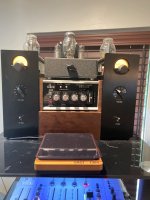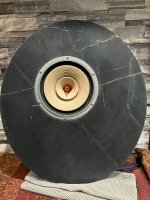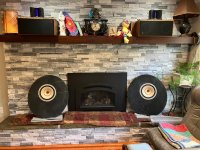@PeteAugello , thanks for the detailed note. I just got my set today and will be firing them up as is tonight. I have a pair of Zu Soul 6's and hopefully these will sound good. I will report back as to how they sound later and maybe will do what you did with the caps-)
Satish
Satish
I'd love to hear what you think.will be firing them ... tonight
I'd also love to hear what someone with an oscilloscope, signal generator and some knowledge thinks! The output transformers are certainly on the small side and an obvious place for the manufacturer to save some money. As far as I know, really good OTs cost more than I paid for these amps. I only have JJ 300Bs installed so there's a lot of room for improvement and cost there. If the circuit is correctly configured and is operating the tubes properly it may be worth the investment.
Pete
I was just reading about Audio Note OTs and came across this line describing their lowest cost line:
"The main cost saving being the use of a smaller core, specified to the exact power level required, rather than overspecifying by 50 or 100%"
This point has made me realize that the size of the core has more to do with power handling than bandwidth, and especially at the very moderate levels I tend to listen with my LaScalas, the stock transformers might be up to the task. That would mean that my money would be better spent on better tubes.
Pete
"The main cost saving being the use of a smaller core, specified to the exact power level required, rather than overspecifying by 50 or 100%"
This point has made me realize that the size of the core has more to do with power handling than bandwidth, and especially at the very moderate levels I tend to listen with my LaScalas, the stock transformers might be up to the task. That would mean that my money would be better spent on better tubes.
Pete
A smaller core, all else equal, means less winding resistance (which is not only a loss issue, but also a distortion issue, because eddy current and hysteresis losses appear across that resistance, and they're very non-linear) and generally less leakage inductance. And maybe slightly less stray capacitances, maybe not. There's no such critter as an Ideal Transformer, only best choices for well specified situations.
Above about a kiloHertz the core is almost unimportant, but at very low frequencies it's pretty much the most important part of a transformer, and there size does matter. What other machine do we expect to operate well over a speed range of 1000 to one? OPTs are a tough gig.
OPT power handling at low frequencies is a second order function inverse of frequency, so every octave lower at any particular power level is four times harder to do. Quadratic limitations are a B; just look at speakers (where everything is second order).
All good fortune,
Chris
Above about a kiloHertz the core is almost unimportant, but at very low frequencies it's pretty much the most important part of a transformer, and there size does matter. What other machine do we expect to operate well over a speed range of 1000 to one? OPTs are a tough gig.
OPT power handling at low frequencies is a second order function inverse of frequency, so every octave lower at any particular power level is four times harder to do. Quadratic limitations are a B; just look at speakers (where everything is second order).
All good fortune,
Chris
Thanks for your response, that all makes sense. I'm not sure how much is stuff that I forgot or that I never knew.All good fortune,
Chris
I'm using these guys with Klipsch LaScalas that I run with subwoofers. In my system I ask very little of the deep bass response of my main amplifiers, lol.
Pete
I had LaScalas in the mid 1970s and regret having to sell them. I used to stack them top-to-top with big cardboard wings extending the mouths and run it in mono. Ah, the 70s.
Paul donated three LaScalas (and three ProSound Heresy's) with flypoints and corners, etc. to Wildwood Park for the Performing Arts, when I was doing sound there. Just before Covid, we finally got them flown (Thank you John Cook and Stageworks!). Big room, 635 generous seats, thrust stage, no proscenium, no flyloft, the whole catastrophy, but it worked out fine.
Paul liked symphonies and Valerie liked opera, so they compromised on opera.
All good fortune,
Chris
Paul donated three LaScalas (and three ProSound Heresy's) with flypoints and corners, etc. to Wildwood Park for the Performing Arts, when I was doing sound there. Just before Covid, we finally got them flown (Thank you John Cook and Stageworks!). Big room, 635 generous seats, thrust stage, no proscenium, no flyloft, the whole catastrophy, but it worked out fine.
Paul liked symphonies and Valerie liked opera, so they compromised on opera.
All good fortune,
Chris
I forgot to ask what voltage you are going to feed these amps? Mine are marked 110vac so I'm using bucking transformers. My 124ish line voltage is higher than I'm comfortable with.I will report back as to how they sound
Have you had a chance to form any first impressions? I continue to be more impressed the more hours that I put on them. Neither the tubes nor the coupling capacitors are fully broken in yet.
Pete
@PeteAugello , sorry for the delay! I was in the middle of upgrading my TT to a Dr feickart Blacbird+Kuzma 4PT. And I have been playing lots of LPs using these. The voltage as I measured from the mains is about 118ish.
These mono blocks are amazing. After about 100 hours on them, the midrange seems to have settled. Ands I have not done anything to the stock tubes. I think they are keepers for sure, my Zu soul 6's are an almost perfect mate for these-). There's tiny hum that I can't seems to get rid off, but that's not really bothering me. The mid range is super smooth, like a glass of a good Vosne Romanee-)
Question is whether I should do do something about the stock 300bs + caps like you did because one always wonders how much better it could be?
These mono blocks are amazing. After about 100 hours on them, the midrange seems to have settled. Ands I have not done anything to the stock tubes. I think they are keepers for sure, my Zu soul 6's are an almost perfect mate for these-). There's tiny hum that I can't seems to get rid off, but that's not really bothering me. The mid range is super smooth, like a glass of a good Vosne Romanee-)
Question is whether I should do do something about the stock 300bs + caps like you did because one always wonders how much better it could be?
Thanks for the update, it's good to know that others are hearing what I hear. After watching Stephe's videos about various Chinese amps and fooling around with a BOYUURANGE Reisong A12 amp I was unsure about how well implemented these amps are. It seems that a lot of Chinese stuff these days is just thrown together to sell to stupid Americans but some was intended for the domestic HiFi market. There are a lot of wealthy people living in Hong Kong!Question is whether I should do do something about the stock 300bs + caps like you did because one always wonders how much better it could be?
It is difficult for me to provide any specific impressions as far as the changes that the capacitor upgrade wrought, but my feeling is that they took the system to the next level. Detail retrieval is outstanding and there is a certain harmonic "rightness" to the sound. There was a tiny bit of grain and glare that was only noticable when it was gone.
I wonder if the next step would be better output transformers. I haven't measured the stock ones yet but I intend to. I really wish that someone with some skill and test equipment would take a look at these things. I MOSTLY trust my ears, but....
Pete
Last edited:
Just wondering how the amps are doing? Have you done any other changes aside from the capacitors? I have a pair of these on the way to me now.
I asked the seller about rectifier tubes and he said that the Russian 5U4M was equivalent to the 5Y3GT and not the 5U4G. Have you tried the 5Y3GT?
Jim
I asked the seller about rectifier tubes and he said that the Russian 5U4M was equivalent to the 5Y3GT and not the 5U4G. Have you tried the 5Y3GT?
Jim
Hi Pete,Hi everyone!
I just got a pair of Chinese 300b Monoblocks from eBay and have some questions and comments, and wonder if anyone who knows what they are doing has looked at them.
The amps that I got are sold by a bunch of different people but they all look the same. There is very little actual identifying labeling, the vendor that I chose has a funKenya banner on the pictures.
I got the version that came with PSVane 300bs and Russian rectifier and driver tubes. It only took two weeks to get to Pennsylvania from Hong Kong! It was very well packaged and the packaging and contents were undamaged.
There was no manual of any sort included, but I don't read Chinese so that isn't a great loss. The case has no identifying markings at all but there is a sticker on the bottom.
The first thing that I did was peal off the warranty stickers over two of the screws holding the side panels so that I could verify which socket is for the driver and which one gets the rectifier. The case is labeled 110 volts in several places so I checked the heater voltage for the 300b and it was almost 6 volts. I built power cords with 10 volt bucking transformers and reduced my line voltage from 123v to 110v and the heater voltage to 5 volts.
I tested them out on the workbench with small speakers and they appeared to be operating properly, so I brought them upstairs and hooked them up to the big system.
Right off the bat they sounded pretty darn good. Not really competitive with my big VTL monoblocks, but they had something to offer over the Skunkie Designs modified A12 that I had hooked up yesterday. After a couple of hours, they really started to sound pretty darn good!
I brought them downstairs and put them back on the bench with the small speakers out of phase and pushed up against each other, and the Sheffield Labs burn-in track running on repeat. I'm going to hook them back up shortly, after 4 hours or so.
My questions:
Has anyone who knows what they are doing looked at these things? They seem more "engineered" than the A12 but I still wonder if the circuit is actually properly designed and implemented.
I would love to get rid of the Russian tubes and use more common types. It comes with a 5U4M rectifier and obviously a 5AR4 would give me more choice and availability, similarly with the 6H8C driver tube, a 6SN7 is a lot easier to come by. I'm pretty sure that I can't just use the "equivalent" tube types, lol.
There is a multi-turn potentiometer on the back but no exposed test point that I can find. Does it seem possible that this amp is configured with adjustable bias? That raises several other questions.
I'm about ready to bite the bullet and order some better 300b's for it but if I can do something about the others while I'm at it that would be great.
Thanks,
PeteView attachment 1203684View attachment 1203685View attachment 1203686View attachment 1203687View attachment 1203688View attachment 1203689View attachment 1203690View attachment 1203691View attachment 1203692
Very nice that you have a set of these, I also have a set!
I'm glad you are getting under the hood to improve, something I intend to do.
I will also replace the cap as you did, can you post the part number for the Audio Note Copper Foil capacitor please?
I use a variac to lower the input voltage and have no problems.
Quite good circuit is same as Sun audio circuit and triode.com audio amplifier 's circuit.
This circuit uses a diode bridge, which is very common these days. The rectifier tube is not used as a rectifier tube, it is just used as a damper for the voltage drop of about 60V. The rectifier tube is not used as a rectifier tube.
I use a Sylvania preamp tube and Gold Lion 300B's
I use these amps to power a set of stone open baffle Lii S-10 speakers.
One of the amps has developed a little buzz that I have not tracked down yet.
Victor at VK music told me changing the output transformer would cost way too much but suggested
Lundahl transformers.
Let us know how you progress...
Attachments
Did you ever measure the heater supplies when you were under the hood? From your first post, it seems like you measured voltages with the tubes not installed. Fixing the heater voltage at this point might be counterproductive.
Would you know how the 5U4M differs from the 5U4G?shakey@ Russian 5U4M give more volts than 5y3gt. About 8% more.
These amps are being offered by different vendors. I’m assuming they all come from the same factory. Right after I ordered my amps I read a show report from the capital audio fest and apparently Altec released the exact same amp for $3500.
Thanks for the info.
This looks like the Audio Note capacitor that replaced the Wima capacitor:Hi Pete,
Very nice that you have a set of these, I also have a set!
I'm glad you are getting under the hood to improve, something I intend to do.
I will also replace the cap as you did, can you post the part number for the Audio Note Copper Foil capacitor please?
I use a variac to lower the input voltage and have no problems.
Quite good circuit is same as Sun audio circuit and triode.com audio amplifier 's circuit.
This circuit uses a diode bridge, which is very common these days. The rectifier tube is not used as a rectifier tube, it is just used as a damper for the voltage drop of about 60V. The rectifier tube is not used as a rectifier tube.
I use a Sylvania preamp tube and Gold Lion 300B's
I use these amps to power a set of stone open baffle Lii S-10 speakers.
One of the amps has developed a little buzz that I have not tracked down yet.
Victor at VK music told me changing the output transformer would cost way too much but suggested
Lundahl transformers.
Let us know how you progress...
https://partsconnexion.com/audio-note-capacitor-0-22uf-630vdc-copper-foil/
This seems implausible. Altec is not listed in the vendor directory for the CAF show and Altec does not sell amps according to their web site.I read a show report from the capital audio fest and apparently Altec released the exact same amp for $3500.
Got a link?
- Home
- Amplifiers
- Tubes / Valves
- FunKenya Chinese 300B Monoblocks


